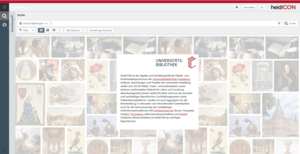Using the NHDP Image Database (HeidICON)
The Nepal Heritage Documentation Project’s visual materials are accessible through HeidICON, Heidelberg University’s digital object and multimedia database. HeidICON hosts all the photographs, scanned drawings, and other media gathered by the project, organized in a dedicated “NHDP” pool. Below is a guide on how to access and search for images, and what kinds of visual resources you can find there:
Accessing NHDP Images on HeidICON
To explore NHDP images, you can directly access the NHDP pool on HeidICON (e.g. via the project link on the NHDP website). No login is required – the content is publicly available worldwide. Once on HeidICON, you will see the NHDP collection interface. You can begin by browsing or using the search bar to find specific images. All items in this pool pertain to the documented Nepali monuments and heritage objects described in DANAM. Each image entry typically includes metadata (such as the monument name or ID, location, and a brief description) to help you understand its context.
Searching for Images and Using Filters
Basic Search: In the NHDP pool on HeidICON, you can perform a simple keyword search. For example, enter the name of a monument, a location, or a category – such as “Bhimsen Temple Patan” or generic terms like “hiti” or “monastery” – and the database will return matching images. This full-text search scans titles, descriptions, and tags associated with the images. It is a quick way to find all photographs related to a particular site or topic.
Advanced Search and Filters: HeidICON also allows filtering by specific fields. You can refine results by attributes like object type, location, or photograph date if such filters are available. For instance, you might filter to show only architectural drawings, or only images from a certain city. The NHDP pool organizes content with consistent metadata (in English, with Nepali names where relevant), so using local place names or monument types can help narrow down results. If you know a specific inventory ID (from DANAM), you can search by that as well. Additionally, you can browse the collection by simply clicking “Zu den Bildern” (to view all images) for NHDP on the HeidICON portal, which will display thumbnails of all items in the NHDP collection. From there, you can navigate or search within those results.
Viewing and Downloading: Clicking on an image thumbnail in the results will bring up the detail view of the image. Here you can see a larger version of the photo or scan, along with detailed information (metadata) such as the title, photographer or source, date taken, and a description of what it depicts. You may also find links to related records (for example, an image might link to the corresponding monument entry in DANAM or to other images of the same site). For academic or non-commercial purposes, these images can typically be downloaded or used following the project’s usage guidelines (crediting NHDP/DANAM as specified).
Types of Images and Media Available
The NHDP image pool in HeidICON contains a rich variety of visual documentation related to Nepal’s cultural heritage. When searching or browsing, you can expect to find:
- Photographs of Monuments: Recent high-resolution photos of the exteriors and interiors of temples, monasteries, palaces, etc., including wide shots of whole structures and close-ups of architectural details. There are also contextual shots showing a monument’s setting in a square or street. These images provide a visual record of the monument’s current condition and artistic features. Historical photographs (from archives or earlier surveys) are included where available, offering a “then-and-now” perspective for certain sites.
- Images of Objects and Art: Many monuments house important objects – statues, icons, ritual paraphernalia, inscriptions on stone or metal, etc. The database includes photographs of such objects in situ or in detail. For example, you might find images of a bronze sculpture from a temple sanctum, a carved wooden strut, a stone caitya (miniature stupa), or even ritual items like bells and lamps that are part of a shrine. Each object image is linked to its monument context and often accompanied by descriptions or transcription (for inscriptions).
- Architectural Plans and Drawings: In addition to photos, NHDP produces architectural drawings for many monuments. These include measured floor plans of temples or monasteries, elevation drawings, cross-sections, and architectural details (like pillar or torana drawings). Such drawings, often created by the project’s architects, are scanned and uploaded to HeidICON. They help researchers see the precise layout and dimensions of structures. There are also site maps and location plans that show where each monument is situated in the urban fabric. These visuals are invaluable for understanding the design and spatial context of the heritage sites.
- Maps of Ritual Routes and Heritage Walks: The project sometimes provides thematic maps – for instance, maps delineating the route of a religious festival procession or a heritage walk that connects multiple monuments. These maps (often hand-drawn or GIS-based) are included as images. They illustrate how different sites (temples, rest houses, water spouts, etc.) link together in cultural practice.
- Photographs of Cultural Activities: Where possible, NHDP also documents intangible heritage associated with the monuments. Thus, you may find photographs of festivals, rituals, or community gatherings taking place at these sites. For example, images of an annual ceremony in a monastery courtyard, or people lighting lamps at a temple during a festival, might be present. Such photos provide context on how the spaces are used and valued in the present day.



